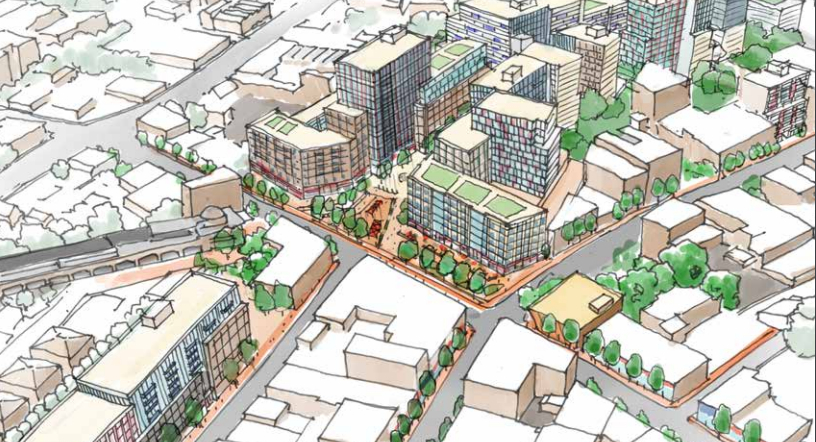
NYCEDC
A drawing from the EDC's literature on the Far Rockaway plan.
On Monday, the City Planning Commission (CPC) voted unanimously to approve the administration’s proposed rezoning of downtown Far Rockaway with no modifications. One commissioner, Michelle de la Uz, was absent.
“It’s exciting to be here on this second of our comprehensive rezonings,” said Marisa Lago, Chair of the City Planning Commission and director of the Department of City Planning. “Far Rockaway was established first as a summer resort, and the fortunes of this town have gone up and down like a roller coaster and I’m confident that with today’s actions Far Rockaway will once again be on the rise.”
The proposal, one of the roughly dozen neighborhood rezonings under discussion or approved as part of the mayor’s affordable housing plan, would increase housing and commercial development in the long-neglected core of Far Rockaway and would accompany a suite of $91 million in city investments.
It’s the second neighborhood rezoning, after East New York, to enter the formal public review process, and compared to other rezonings has encountered less resistance. Both Queens Community Board 14 and Queens Borough President Melinda Katz approved the rezoning, though with a substantial list of conditions including less density and a new school. Residents have voiced concerns about too much density, the need for local, well-paying jobs, and gentrification.
“Today’s vote marks another major step towards bringing transformative investment to Downtown Far Rockaway. We were grateful to receive the support of the City Planning Commission and look forward to continuing to work with Council Member Richards and other community leaders as we move forward with this historic effort to revitalize Downtown Far Rockaway,” said Anthony Hogrebe, NYCEDC Senior Vice President of Public Affairs, in a press release.
Before casting her vote, Commissioner Ana Levin said she would have preferred if the commission were not voting on one particular land use action encompassed within the rezoning proposal: the disposal of a lot owned by the Department of Sanitation to a private developer.
“I think we heard compelling testimony from many folks in the community about the importance of keeping the sanitation site in city-ownership until appropriate use for that site is determined,” she said, referring to the calls of community activists to use that site for an urban farm and community garden rather than housing.
On June 28, the New York City Economic Development Corporation (EDC), which is spearheading the rezoning, wrote in a letter to the City Planning Commission that “Prior to any disposition of the site, [EDC] will meet with community members and stakeholders to gather feedback about what uses are desired.”
EDC, in another document, says that it will “inventory City-owned property within Downtown Far Rockaway as well as throughout the peninsula that would be suitable sites for community farming or gardening.”
That document, the Final Environmental Impact Statement (FEIS), was released on June 29 and provides a window into how EDC’s rezoning proposal has changed—or not changed—as a result of community feedback over the past few months. EDC has pleased the community board by adding buildings height limits on certain streets and adding new design requirements, but, to the board’s frustration, has also expanded the rezoning to two more development sites that will result in a net increase in apartments generated by the rezoning.
The FEIS also provides updates on the strategies the city will use to mitigate the projected negative effects of the rezoning, such as an expected deficit of 209 childcare seats. The city has not budgeted for the creation of a childcare center in the area, but will encourage developers applying to build in the Urban Renewal Area (URA) to include a childcare facility. The FEIS says that existing schools will be able to accommodate the population increase, despite community members’ arguments to the contrary.
The city does not propose a strategy to mitigate the deficit of open space in the area, but says it will continue exploring strategies to address the issue. There will also be some unmitigated negative impacts related to traffic and construction. The city is hoping the MTA will add new buses to relieve potential overcrowding on public transit.
Next, the City Council subcommittee on Zoning and Franchises, which happens to be chaired by Rockaway councilman Donovan Richards, will host a hearing on the proposal on Thursday July 27, 9:30 am at City Hall.
It is likely that Richards, whose leadership has been key to the rezoning proposal’s creation, will support the initiative while also calling for changes and investments to meet community demands.









2 thoughts on “Far Rockaway Rezoning Sails Through City Planning Commission”
Pingback: This Week in New York City Government - Capalino + Company
Pingback: Time To Take Out The Garbage |